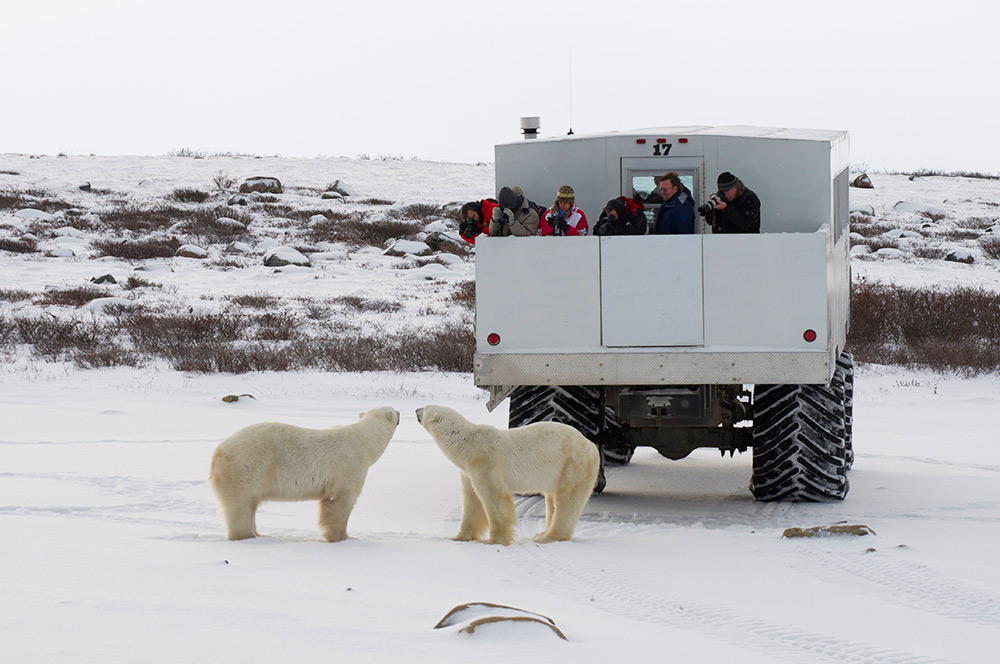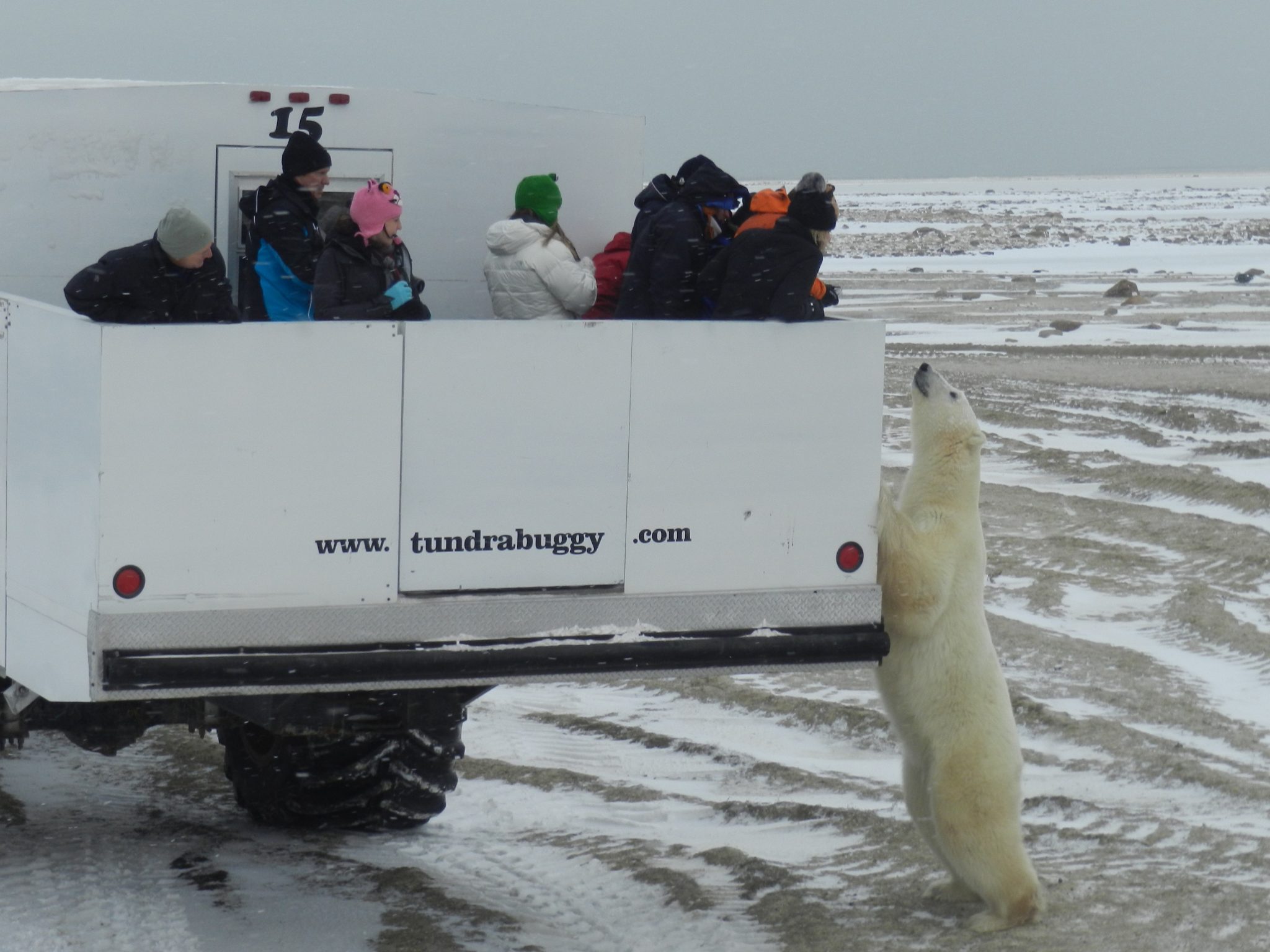From my window I’m watching polar bears have the time of their life while I am tucked up in bed in a warm Tundra Buggy Lodge near Churchill in Canada.
They are rolling, stretching, tumbling and sparring with each other as polar bear fans from all corners of the world watch their antics.
Churchill in northern Manitoba on the west shore of Hudson Bay is considered the polar bear capital of the world and for a short time each year, animal lovers head to the area to see these bears in their pristine environment and watch their natural behaviour.
That first sighting
Nothing quite prepares you for your first sighting of these magnificent animals in the wild that intrigue, amuse and entertain as their daily lives unfold in front of you.
I quickly learn that polar bear watching is addictive and I don’t want to miss a thing.
Eyes are peeled to the windows as we head to breakfast and there’s a squeal as someone spots a hefty polar bear inspecting the huge tyre on the buggy.
Throughout breakfast in the dining car everyone has one eye on the windows but staff say they are used to that.
It’s about minus 12 outside but our “lodge mamma” Emma Acorn, who makes the best muffins and cookies says “No, this isn’t cold – you should be here when it’s minus 26,” as she serves us a hearty breakfast.
Frontiers North Adventures offers great polar bear day trips from Churchill but a stay on the tundra stationed about 20 kilometres east of the town is a great way to immerse yourself in a polar bear experience and saves time spent on travelling in and out from town.
Home Sweet Home
The lodge is a cosy home away from home with comfortable dormitory-style accommodation units with upper and lower sleeping berths, each with a window and reading lamp, adjustable heating and a sound-dampening curtain for privacy that also separates the berths from the central aisle. Each unit has three shared bathrooms with lots of hot water.
There is also a cosy lounge where wildlife experts provide educational sessions about polar bears and guests can meet other animal lovers, enjoy a game of cards and watch impromptu concerts by staff after dinner.
Meals are tasty and hearty – for breakfast it is pancakes and bacon and eggs with homemade soup, sandwiches and salads for lunch that is usually eaten in the Tundra Buggy. For dinner chicken, beef, fish or pasta and regional treats such as bison and Arctic char are on the menu and there’s always a tasty dessert as well.
So why does Churchill attract so many polar bears?
Every autumn, polar bears gather at Cape Churchill to wait for the ice to form and be ready for the start of the early seal hunting season.
It provides a pocket of opportunity for tourists to see the bears in action, taking a nap, sparring, searching for lichen and amusing themselves while they wait.
Tundra Buggy
Each day we head out to watch polar bears interact with each other on the snow and ice from the safety and comfort of a Tundra Buggy with knowledgeable guides who have many bear stories to tell.
Specially designed, the all-terrain tundra buggies travel into the 85,000 hectare Churchill Wildlife Management Area that is the largest wildlife management area in Manitoba.
The heated buggy is warm but we still dress in snow gear to combat the chills of minus 14 degrees and icy cold winds we encounter on the open viewing area – the best place for photographs.
Our guide, wildlife biologist Angele Watrin says the conditions are pretty good at this time of the yea. She’s often out in extreme weather and it can get down to minus 30 which she describes as “pretty cold.”
As the day progresses polar bears wander by and stand up along the side of the buggy to see what is going on.
“Polar bears are so inquisitive and very entertaining but even though they look cute and cuddly they are extremely dangerous,”says Angele.
She keeps a close eye out for other tundra animals and we see an Arctic fox and a snowy owl perched on the rocky shore of Hudson Bay.
While we are snapping away, there’s a bang on the buggy and a very large paw can be seen on the locked steps below. It’s huge with sharpened claws that could ripe anything apart.
Angele tells us the paws are perfect for roaming the Arctic and the bears use their claws to catch and hold prey and to provide traction on the ice.
“Paws measure up to 32 centimetres across and help distribute weight when treading on thin ice,” she says.
“When ice is very thin, polar bears stretch their legs far apart and lower their bodies to distribute their weight even more and they are expert at placing each paw precisely and quietly when stalking seals.”
The Future?
After three days of intensive polar bear spotting I am completely under their spell, but it is the threatened environment of polar bears that has us concerned for their future.
At a lecture by Polar Bear International, we learn how global warming is affecting their environment.
Polar Bear International is the world’s leading polar bear conservation group dedicated to saving polar bears by saving their habitat.
Dr Steven Amstrup, the chief scientist at Polar Bears International that is sponsored by Frontiers North, says global warming is posing a threat to their future by altering summer time ice flows and feeding patterns.
But he believes it is not too late to implement steep and rapid greenhouse gas reductions to preserve the sea ice world that polar bears require.
As well as research, Polar Bears International spreads the word about polar bears and their environment via televised classes to many schools. There is also the Polar Bear Cam that connects people with polar bears, inspiring them to care about these magnificent, but threatened species.
Each year about 900 polar bears wait for Hudson Bay to freeze over so they can finally go on the hunt for seals on the ice. October and November are the months of the year when the polar bears are most active congregating along the coast anticipating the Hudson Bay freeze up.
Dr Amstrup says the stakes are high for polar bears but he is optimistic.
“This is a human-caused problem and humans can fix it,” he says.
We all hope he’s right as these magnificent animals are a sheer joy to behold.
Churchill
After several days on the tundra and a complete polar bear immersion, we head back into Churchill, home to about 1000 people.
We stop at the interesting Eskimo Museum that is filled with artefacts and Inuit stone, bone and ivory carvings depicting polar bears and other wildlife.
It was established in 1944 by Roman Catholic missionaries who recognised the value of preserving carvings representative of the culture of the people of the north.
The museum pays tribute to the creativity of the Inuit and early settlers who came to trap and hunt in the area.
Churchill, situated at the estuary of the Churchill River at Hudson Bay, is located directly below the Aurora Borealis – or Northern Lights, and considered a great place to watch the colourful sky phenomenon.
The town is certainly unique and there’s an unwritten law that residents don’t lock car doors and leave their front and back doors open for a good reason.
They provide a quick escape route for anyone who may run into an inquisitive polar bear looking for food.
Although uncommon these days, there are tales of residents coming face to face with a polar bear or seeing a large paw come through an open window.
Churchill even has a polar bear lock up with 26 cells where rogue polar bears who stray a little too close to the town are locked up for 30 days and then relocated.
A polar bear alert operates to prevent the animals becoming conditioned to scavenging for food.
Churchill is also known as a great place to view beluga whales with more than 3000 whales sighted in the summer months.
But for me it’s the polar bears that will always hold a special place in my heart after this once in a life time experience.
Norse poets of the past describe polar bears as great lonely roamers and the sailors of the floes – long may they reign along the shores of Churchill.
Fast Facts
Frontiers North Adventures offers a range of sustainable and responsible tours including Manitoba’s Big Five – the moose, black bear, bison, beluga whale and polar bears in August. Three-night stays at the Tundra Buggy Lodge and daily excursions to see the polar bears in October and November and Northern Lights Tour and Belugas, Bears and Blooms in July and August.
For tour details see frontiersnorth.com
Polar Bear International is the world’s leading polar bear conservation group dedicated to saving polar bears by saving their habitat. Frontiers North Adventures sponsors the Organisation for details visit polarbearsinternational.org





